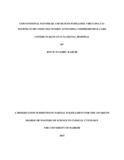| dc.contributor.author | Karuri, Joyce W | |
| dc.date.accessioned | 2016-04-21T15:15:01Z | |
| dc.date.available | 2016-04-21T15:15:01Z | |
| dc.date.issued | 2015 | |
| dc.identifier.uri | http://hdl.handle.net/11295/94689 | |
| dc.description.abstract | Background: Cervical cancer is the second most common cancer among women worldwide with 85% of cases occurring in developing countries. People living with Human Immunodeficiency Virus (HIV) have substantially higher risk for certain types of cancer, including cervical cancer compared to uninfected people of the same age. HIV infected women are at least five times more likely to be diagnosed with cervical cancer.
Pap smear has low sensitivity due to the fact that cytological criteria for the detection are not always present. Reflex Human Papilloma Virus Deoxyribonucleic Acid (HPV DNA) testing co-collected with conventional Pap smear is the preferred approach because it is more sensitive than a single repeat Pap test.
Objective: To determine the utility of co-testing by conventional Pap smear and HPVDNA testing in screening HIV infected women attending Comprehensive Care Centre (CCC) in Kenyatta National Hospital (KNH).
Study design: This was a cross- sectional descriptive study.
Setting: Comprehensive Care Centre (CCC), cytology laboratory, Kenyatta National Hospital (KNH) and Kenya Aids Vaccine Institute (KAVI) molecular laboratory, between August and December 2014.
Participants: A total of 119 HIV positive women aged 25 years and above were recruited from the CCC in KNH.
Material and methods: Demographic and clinical information was obtained by direct interview of the patients. Pap smears were collected by two nurses in a standard manner to ensure the quality of Pap smears and also collected HPV DNA samples using DNA Pap sampler and placed the brush into the preservative provided in the kit. Pap smears were stained using standard staining protocol, and then signed out by the principal investigator (PI) and the supervisors. The HPVDNA samples were preserved at -20oC and processed in KAVI molecular laboratory and results were confirmed by the immunologist supervisor.
Results: A total of 119 patients were recruited. The mean age was 39.9 years (±6.96). About 63.9% were negative for intraepithelial lesion or malignancy (NILM) while 36.1% had atypical squamous cells of undetermined significance (ASCUS) or worse on Pap smear. The commonest lesion reported was high grade squamous intraepithelial lesion (HSIL) (13.4%) followed by ASCUS (7.6%), squamous cell carcinoma (SCC) (6.7%) and low grade intraepithelial lesion (LSIL) (4.2%). Fourteen patients (11.7%) had infections, of these (9.2%) bacterial vaginosis and (2.5%) Candida. High risk (HR) HPV DNA was prevalent in 36.27% cases. Out of a total of 66 women whose Pap smears were reported as NILM, (9%) of them were positive for HR-HPV DNA. Seven Pap smears were reported as ASCUS of which 4 were positive for HR-HPV DNA test. All the squamous cell carcinomas were positive for HR-HPV DNA. The correlation between Pap smear cytology findings and HR-HPV DNA testing was found to be statistically significant with (p=0.001). | en_US |
| dc.language.iso | en | en_US |
| dc.publisher | University of Nairobi | en_US |
| dc.subject | Conventional pap smear , human papilloma virus ,DNA co-testing,hiv infected women,comprehensive care Centre | en_US |
| dc.title | Conventional pap smear and human papilloma virus DNA co-testing in HIV infected women attending comprehensive care Centre in Kenyatta National Hospital | en_US |
| dc.type | Thesis | en_US |
| dc.description.department | a
Department of Psychiatry, University of Nairobi, ; bDepartment of Mental Health, School of Medicine,
Moi University, Eldoret, Kenya | |

